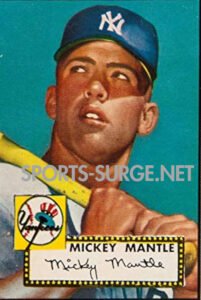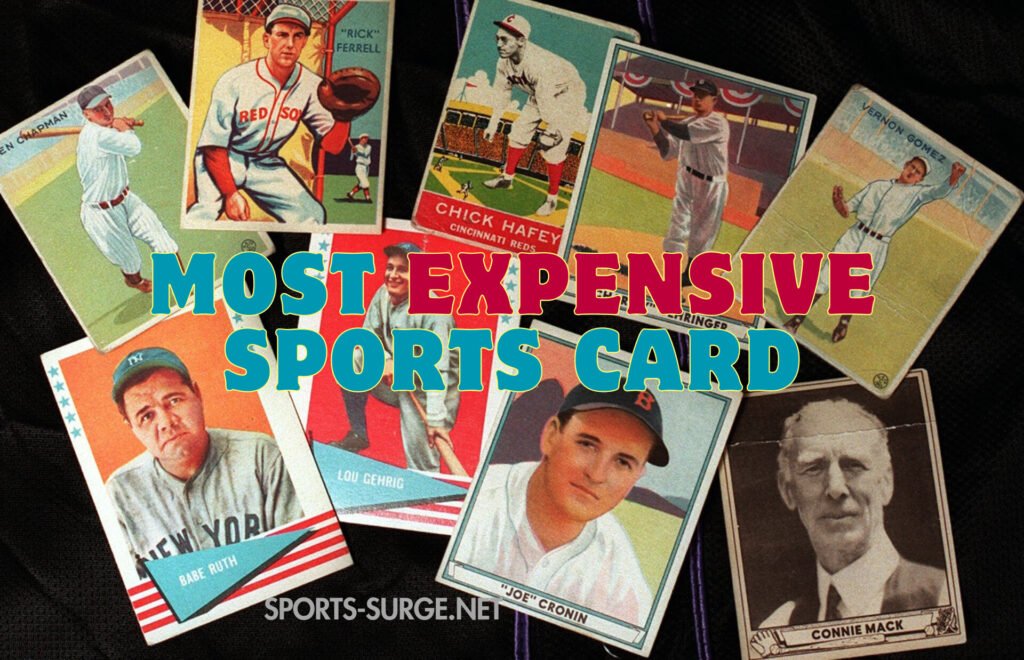The world of sports card collecting has experienced a remarkable surge in interest and value, particularly in the United States. Collectors and investors alike are captivated by the allure of rare and historically significant cards, some commanding prices in the millions. This blog post delves into the most expensive sports card as of 2024, exploring their histories, the athletes they feature, and the factors contributing to their extraordinary valuations.
Table of Contents
Toggle1952 Topps Mickey Mantle #311

The 1952 Topps Mickey Mantle card is often regarded as the “Holy Grail” of sports cards. In January 2024, a gem mint condition example of this card fetched a staggering $12.6 million at Heritage Auctions, setting a new record for sports memorabilia sales.
Mickey Mantle, a legendary switch-hitter for the New York Yankees, had an illustrious career, contributing to seven World Series titles and earning three American League MVP awards. The 1952 Topps card, despite not being his rookie card, holds immense value due to its rarity, historical significance, and the iconic status of Mantle in baseball history.
1909-1911 T206 Honus Wagner
The T206 Honus Wagner card is synonymous with rarity and prestige in the sports card realm. In August 2022, a specimen sold for $7.25 million in a private sale, underscoring its enduring value among collectors.
Honus Wagner, known as “The Flying Dutchman,” was a dominant shortstop for the Pittsburgh Pirates. The scarcity of his T206 card is attributed to Wagner’s objection to the card’s production, leading to a limited print run. This scarcity, combined with Wagner’s Hall of Fame career, makes this card exceptionally valuable.
1914 Baltimore News Babe Ruth
A 1914 Baltimore News Babe Ruth card, depicting Ruth as a minor league pitcher, is among the rarest baseball cards. In December 2023, a red version of this card, graded SGC 3, sold for $7.2 million, making it one of the most expensive sports cards ever.
Babe Ruth’s transition from a dominant pitcher to one of the greatest hitters in baseball history adds profound historical significance to this card. Its rarity and the depiction of Ruth at the onset of his legendary career contribute to its immense value.
2000 Playoff Contenders Championship Ticket Autograph Tom Brady #144

Tom Brady’s 2000 Playoff Contenders Championship Ticket Autograph card is a modern treasure in the sports card industry. In March 2024, a pristine example sold for $7.2 million at Goldin Auctions, reflecting Brady’s status as one of the greatest quarterbacks in NFL history.
Brady’s unparalleled achievements, including seven Super Bowl victories and multiple MVP awards, elevate the desirability of his rookie cards. The combination of rarity, condition, and Brady’s legendary career trajectory drives the value of this card.
2003-04 Upper Deck Exquisite Collection LeBron James Rookie Patch Autograph
LeBron James’ rookie patch autograph card from the 2003-04 Upper Deck Exquisite Collection is a centerpiece for basketball card collectors. In June 2024, a high-graded version sold for $5.7 million, highlighting James’ impact on the sport.
LeBron James, often compared to Michael Jordan, has solidified his legacy with multiple NBA championships and MVP awards. This card’s value is amplified by its limited production, on-card autograph, and a piece of game-worn jersey, encapsulating a significant era in basketball history.
1986-87 Fleer Michael Jordan Rookie Card (Gem Mint)
Michael Jordan’s 1986-87 Fleer rookie card remains a cornerstone of basketball card collections. In April 2024, a gem mint example achieved a sale price of $4.9 million in a private transaction, reflecting Jordan’s enduring influence on the sport.
Jordan’s global impact, six NBA championships, and cultural significance through ventures like “Space Jam” contribute to the card’s value. The 1986-87 Fleer set is iconic, and Jordan’s rookie card is its most coveted piece.
2018 Panini National Treasures Luka Dončić Logoman Autograph Rookie Card
Luka Dončić’s 2018 Panini National Treasures Logoman Autograph Rookie Card represents the new generation of basketball talent. In July 2024, this card sold for $3.7 million, indicating the high expectations and admiration for Dončić’s burgeoning career.
Dončić’s rapid ascent in the NBA, marked by record-breaking performances and All-Star selections, makes his rookie cards highly sought after. The Logoman patch, combined with an autograph and one-of-one designation, significantly enhances its value.
1933 Goudey Babe Ruth #53
The 1933 Goudey Babe Ruth #53 card, known as the “Yellow Ruth,” is a vintage classic. In July 2021, a PSA 9 graded example sold for $4.21 million, underscoring Ruth’s legendary status in baseball lore.
Babe Ruth’s larger-than-life persona and transformative impact on baseball make his memorabilia highly desirable. The 1933 Goudey set is renowned among collectors, and the #53 card is particularly esteemed due to its design and rarity in high grades.
2009 Bowman Chrome Draft Prospects Superfractor Autograph Mike Trout #BDPP89

Mike Trout’s 2009 Bowman Chrome Draft Prospects Superfractor Autograph card is a modern baseball masterpiece. In August 2024, a graded BGS 9 copy of this one-of-one card sold for $4 million in a private transaction. This sale underscores Trout’s impact as one of the greatest players of his generation.
Trout’s remarkable career with the Los Angeles Angels, characterized by three MVP awards, multiple All-Star appearances, and consistent dominance in the league, cements his legacy. The rarity of this Superfractor card, paired with Trout’s autograph and its pristine condition, makes it a treasure in the world of sports cards.
What Makes Sports Cards So Valuable?
The astronomical prices of these cards are driven by a combination of rarity, condition, historical significance, and the athlete’s career achievements. Let’s break it down:
- Rarity: Cards with limited production runs or one-of-one designs are inherently more valuable due to their exclusivity. For example, Superfractor and Logoman cards are highly sought after for their uniqueness.
- Condition: The grade of a card, determined by companies like PSA or Beckett Grading Services (BGS), plays a significant role. Cards in gem mint or pristine condition fetch much higher prices.
- Historical and Cultural Significance: Cards tied to legendary athletes, groundbreaking moments, or iconic designs hold immense nostalgic and cultural value. For example, the 1952 Mickey Mantle Topps card represents a golden era of baseball card collecting.
- Athlete Legacy: The career achievements and personal brand of the athlete featured on the card directly influence its value. Players like Babe Ruth, Michael Jordan, and Tom Brady transcend their respective sports, making their memorabilia universally appealing.
- Market Demand: The surge in demand for sports cards, fueled by both traditional collectors and a new wave of investors, has driven prices to unprecedented levels. The integration of sports cards into alternative investment portfolios has also contributed to their rise.
The Future of Sports Card Collecting
As of 2024, the sports card market in the USA shows no signs of slowing down. The introduction of blockchain technology and NFTs has created new opportunities for digital trading cards. Companies like Panini and Topps are incorporating these innovations, ensuring that the hobby continues to evolve with the times.
Moreover, the increasing global appeal of sports and the rise of international stars like Luka Dončić and Shohei Ohtani are expanding the market beyond the United States. This globalization, coupled with the continued growth of online marketplaces and auction platforms, is likely to drive the hobby forward.
Conclusion
The world Most Expensive Sports Card collecting is a fascinating blend of nostalgia, investment, and passion. From vintage classics like the 1909 T206 Honus Wagner to modern marvels like the 2003-04 LeBron James Rookie Patch Autograph, each card tells a story of athletic excellence and historical significance.
As new stars emerge and collectors continue to invest, the value and appeal of these cards will only grow. Whether you’re a seasoned collector or a newcomer to the hobby, the thrill of discovering and owning a piece of sports history is unparalleled. In a world where moments fade, sports cards serve as enduring reminders of the greatness that defines our favorite athletes and the games we love.
FAQs about Most Expensive Sports Card
What is the most expensive sports card ever sold?
The record for the most expensive sports card is held by a 1952 Topps Mickey Mantle card, which sold for $12.6 million in August 2022. This card, graded SGC Mint+ 9.5, is renowned for its rarity and the legendary status of Mickey Mantle.
Why are vintage sports cards like the T206 Honus Wagner so valuable?
Vintage sports cards, such as the T206 Honus Wagner, command high prices due to their scarcity, historical significance, and the iconic athletes they feature. The T206 Honus Wagner card, for instance, is often referred to as the “Holy Grail” of sports cards because of its limited production and the legendary career of Honus Wagner.
How do modern sports cards achieve multi-million dollar valuations?
Modern sports cards can reach substantial valuations when they feature exceptional athletes, are produced in limited quantities, and include unique elements like autographs or game-worn memorabilia. For example, a 2003-04 Upper Deck Exquisite Collection LeBron James Rookie Patch Autograph card sold for $5.2 million in April 2021, highlighting the demand for high-quality, limited-edition modern cards.
What factors determine the value of a sports card?
Several factors influence a sports card’s value:
- Rarity: Limited print runs or unique cards are more valuable.
- Condition: Cards graded higher on scales like PSA or BGS fetch higher prices.
- Historical Significance: Cards featuring legendary athletes or milestone moments are highly sought after.
- Market Demand: The popularity of the athlete and current market trends can drive value.
Are autographed sports cards more valuable than non-autographed ones?
Autographed sports cards often hold higher value, especially when the signature is authenticated and the card is in excellent condition. The presence of an autograph adds a personal connection to the athlete, increasing desirability among collectors.
How has the sports card market evolved in recent years?
The sports card market has experienced significant growth, with increasing interest from both collectors and investors. High-profile sales, such as the $12.6 million Mickey Mantle card, have brought mainstream attention to the hobby. Additionally, the rise of online marketplaces and digital platforms has made trading and collecting more accessible, further expanding the market’s reach.
These questions reflect the dynamic nature of sports card collecting, where historical artifacts and modern treasures alike capture the fascination of enthusiasts worldwide.

